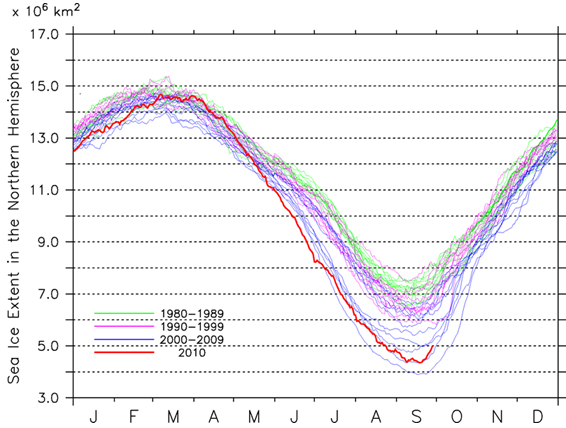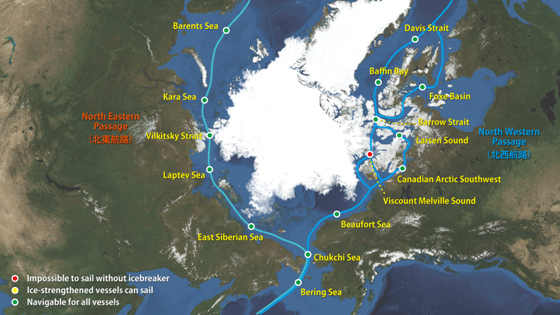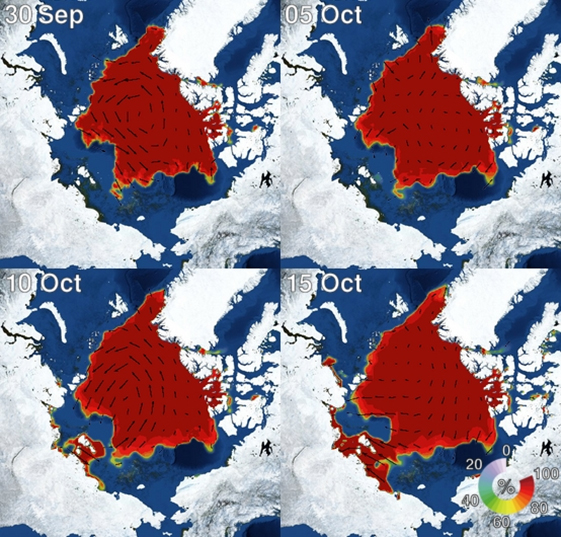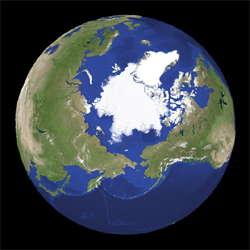2010.09.30
The Arctic sea ice has begun to expand again, soon closing the polar routes.
Topic of the Week
Continuing from last week, both of the polar routes have remained open. This circumstance, however, is expected to end sometime soon, as data show that seasonal sea ice recession in the Arctic has already ended, and the annual cycle of sea ice growth has just begun on both sides of the Arctic Ocean.
In the western Arctic, the south route of the Northwestern Passage, which opened last week, has been narrowing because of some growing new ice across several key areas along the sailing route. In the eastern Arctic, the Northeastern Passage along Russian Coast has been free of ice and thus remained navigable. Presently, the Arctic Ocean has shown a remarkable increase of sea ice extent mainly due to a rapid freezing in the western part of the region. So far moderate ice freezing in the eastern Arctic will also be accelerated through the next month. Both of the passages will be closed again within the next couple of weeks.
Sea Ice Extent

|
Arctic Western Arctic Eastern Arctic |
Figure 1a-1c. Sea ice extent of the entire Arctic(1a), western Arctic(1b), and eastern Arctic(1c)
Figure 1a-1c show the daily Arctic sea ice extents in the entire Arctic, western Arctic, and eastern Arctic oceans, respectively, along with the extent curves observed for the past thirty years.
The Arctic sea ice extent as of 28 September 2010 is estimated to be approximately 5.0 million square kilometers, an increase of about 0.5 million square kilometers since last week (Figure 1a). The current extent in the western Arctic is about 2.8 million square kilometers (Figure 1b). The plot clearly shows that the ice freezing in the region has proceeding rapidly over the past week. This significant growth rate in the primary stage of the winter seasonal freezing after the substantial ice decline is consistent with a trend seen in recent years. As for the eastern Arctic, the current ice extent is approximately 2.2 million square kilometers (Figure 1c). The plot suggests that the sea ice in the region has already begun to increase, but with a moderate pace in contrast to the western Arctic.
Figure 2 illustrates a snapshot of the current Arctic sea ice distribution based on passive microwave satellite imagery. The Arctic sea ice is forecast to maintain the rapid growth rate through the next month, and the main body of sea ice around the North Pole will gradually expand towards lower latitude over the next several months.
Sea Ice Conditions along Polar Routes

Figure 3. Sea ice condition around the North Eastern and North Western passages.
Figure 3 depicts the present conditions of the Arctic polar routes. Continuing from the previous period, both of the Northwestern and Northeastern Passages have remained open. The south route, the only presently navigable route in the NW passage, has been gradually narrowing due to emerging new ice across coastlines of Barrow Strait and the mouth of Lancaster Sound. A discernible increase of sea ice coverage in Viscount Melville Sound suggests that it is less likely for the north route of the passage to become navigable within this season. Both of the NW and NE passages will soon be closed again.
Model Prediction
Figure 4 illustrates the forecast of the Arctic sea ice in 30 September to 15 October based on predictions done by Weathernews' “I-SEE Engine". The model output suggests that the sea ice will begin to expand largely along Russian coastal areas, in particular, in the East Siberian Sea and the Laptev Sea. This may possibly be attributed to the fact that oceans in those regions are relatively shallow, and water temperatures reach more quickly the freezing temperature than those in deeper oceans, promoting ice formation in the early stage of the winter season.

Figure 4. I-SEE engine model predictions of Arctic sea ice.


